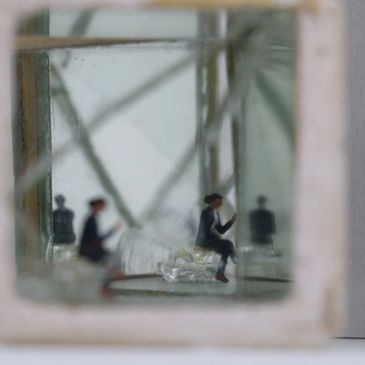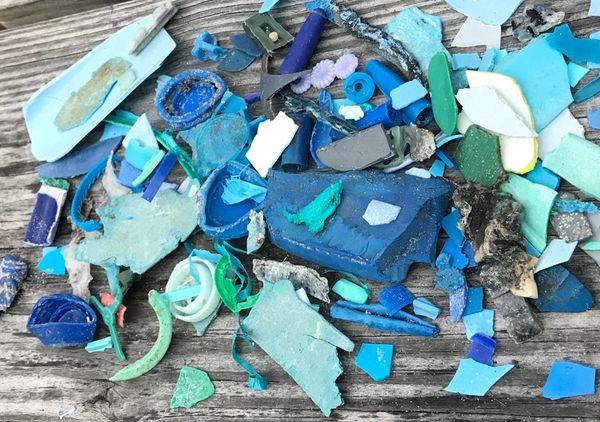

About Me
My Background
My Background
My Background
Born in Barranquilla, Colombia.
Political Science graduate from Universidad de los Andes in Bogotá, later specialized in video editing at New York University. Her interest in visual arts grew in the 90s; and attended SCAD, Savannah College of Art and Design, where she ventured in courses in digital art and sculpture, among others. She c
Born in Barranquilla, Colombia.
Political Science graduate from Universidad de los Andes in Bogotá, later specialized in video editing at New York University. Her interest in visual arts grew in the 90s; and attended SCAD, Savannah College of Art and Design, where she ventured in courses in digital art and sculpture, among others. She continued to connect her passion for art with history. Her experimental narrative shows persistent observations of reality. Pieces that release historical arguments of war and violence constantly present in her native Colombia; scenes of globalization, human waste, and technology’s influence on man, take shape and dynamism through her compositions. These past years have been important for Bibiana. A solo exhibition in Paris, France; and being part of collective art exhibits in Dallas and Miami (USA), at Museo del Chicó in Bogotá, Colombia, and in JUSTMAD at Madrid, Spain. She was selected to exhibit at Florence Biennale in Italy representing Colombia last October 2019. Recently moved to Miami, and currently working at her studio at Fountainhead in Little River, Miami.

Medium
My Background
My Background
From a young age she was drawn to the idea of constructing figures with different elements collected in time, and bringing them together through painting.
Aesthetics which jump between iconography and conceptualism, give rise to artwork that is built from mixed materials and techniques. The recollection of miniatures, metals, garbage, jewe
From a young age she was drawn to the idea of constructing figures with different elements collected in time, and bringing them together through painting.
Aesthetics which jump between iconography and conceptualism, give rise to artwork that is built from mixed materials and techniques. The recollection of miniatures, metals, garbage, jewels, rhinestones and an endless number of elements in apparent disuse, started to get involved with her drawings in the assembly of dynamic pieces of art, thus leading to a sensation of wavelength that create subatomic movement on the pieces. Some built on canvas and some 3D scenarios.
Her artwork is a constant expression of an inspirational process that overcomes any philosophical resources. Her artistic practice is meticulously conceived in a process of preciousness and configuration. In the series “scenarios” the artist stages situations in small format boxes. Shaped and scenically acquiesced, the characters and elements meddle in dreamy scenes related to human behavior. Built by assembling miniature objects and props that evolve to a particular atmosphere, intuitive sentiments and themes titled by the most used #hashtags.
My Blog

Plastic Ocean Wave
Project Information
The recollection of miniatures, metals, garbage, jewels, rhinestones and an endless number of elements in apparent disuse has been always part of my art.
I have been picking up plastic waste from the beach for more than 7 years since I moved to Miami. The colors, sizes, textures and shapes of all these types of polymer plastic pieces are unexpected after being outdoors.
I made a prototype, a 3D model of a waste ocean wave sculpture. It was built on a rectangular frame, from an improvised metal net structure and making lawyers of plastic, glass and elements found at the beach. It was a way to experiment the volumes, tones, shapes, lawyers, height and depth.
I want to build a big plastic ocean wave sculpture. 9-10 feet long, 6-7 feet highest wave pikes, and 5-6 feet width approximately. Size can be modified and adapt to the exhibiting place.
The structure of the wave will be built from a special recycle- metal net. (without the frame)
We will design the 3d shape and the resulting net structure.
I will start to cover the structure with all kind of medium and big size plastic pieces and used polymer containers that could en up in landfills. As the layers start to shape the wave, the final layers will have the colors and tones of the transformed and decayed plastics, glass and other elements, combining colors and textures to resemble a sea wave.
I have seen many waste/plastic sculptures and interventions in public spaces made by many artists around the globe. My wave is different.
Learn More
Since I’ve always worked assembling small pieces and creating shapes from smaller elements as the pixels for an image; these waste pieces called my attention. There was a special beauty in these horrible plastic pieces. They were deteriorated, broken, worn away, discolored, transformed by corrosion, perforated, etc. The colors of all these types of polymer plastics pieces are unexpected after being outdoors, inside or floating in the ocean for different periods of time. The shapes, the decayed color palette, lawyers and faded tones are amazing. The colors, specially the fades blues and whites, plus the glass pieces resemble to the ocean’s colors.
For many years I have been interested in recycling processes and involved in different kinds of proposals to maximize recycling products in my community. Some of the projects include recollection of all types of old clothes to make fabric shopping bags that can be reused, implementing compost techniques, and organizing beach clean-ups with students, among others.
In Colombia, I organized a perfect clean recycling system in my neighborhood. Only 40 homes, but we ended up delivering a perfect scenario of recycling. Glass (washed and clean), paper and cardboard (cleaned and separated), plastic (recyclable polymers divided in: beverage bottles, detergent containers, one use plastic -that was collected by people that could reuse in different industries-, plastic bags -all kind of bags from supermarket, chips and all type of snacks packages- that were put into 1 liter plastic bottles and after filled up and pressed down until there is no space in the bottle, they were used to build homes in vulnerable communities in my country.
We also collected metals, wood, fabrics and clothes (clean secondhand clothes, fabrics, cushions, pillows, etc.) Every material had a specific bin and was picked up -mostly by independent, unemployed low-income collectors-, that travel from one neighborhood to another picking up the materials for the correct recycle company and small business that would use it.
Recycling in the community I live today
In Miami I have visited twice the Dade County’s waste management site at Pembroke Pines. It is a one channel recycle which means people don’t separate nor clean the recyclables materials, they just put all together in the same bin: plastic, paper, glass, etc. It is the less effective method; the recyclable products get dirty with container’s leftovers and most of the material gets contaminated and when they arrive to the site, cannot be recycled .
The company that won the bid in most of Dade counties is the same company that used to pick up the garbage in those counties. It had the infrastructure for the recollection. The garbage and the recycle products travel to the site in the same trucks. When the recyclables are picked-up they are all thrown in the truck wagon container where the glasses break, the food spills all over, etc. Most of the recyclable’s containers get contaminated with decomposing food, and more than 90% of the paper products -boxes, magazines, catalogs, etc.- get ruined just because the way the process is made. The glass is not recycled. There is high cost for its transportation, the bottles and other glass objects arrive broken to the recycling plant. In the separation process the glass is put away into trucks and sent for free to cement factories. There are many details around recycling methods in these cities near Miami, it is sad to realize that recycling is just a business for private companies that only care for profits. Educating habitants about it is crucial. Most of the county parks and beaches that have bins for different recycling materials do not work because the waste is never proper disposed.
Recycling is not the solution for the waste problem, it takes a lot of energy to process, and if it is not done with the correct protocols everything ends up buried on landfills and incinerators.
Photo Gallery






MURAL gun control
Check out this great video
Photo Gallery MURAL "gun CONTROL"





